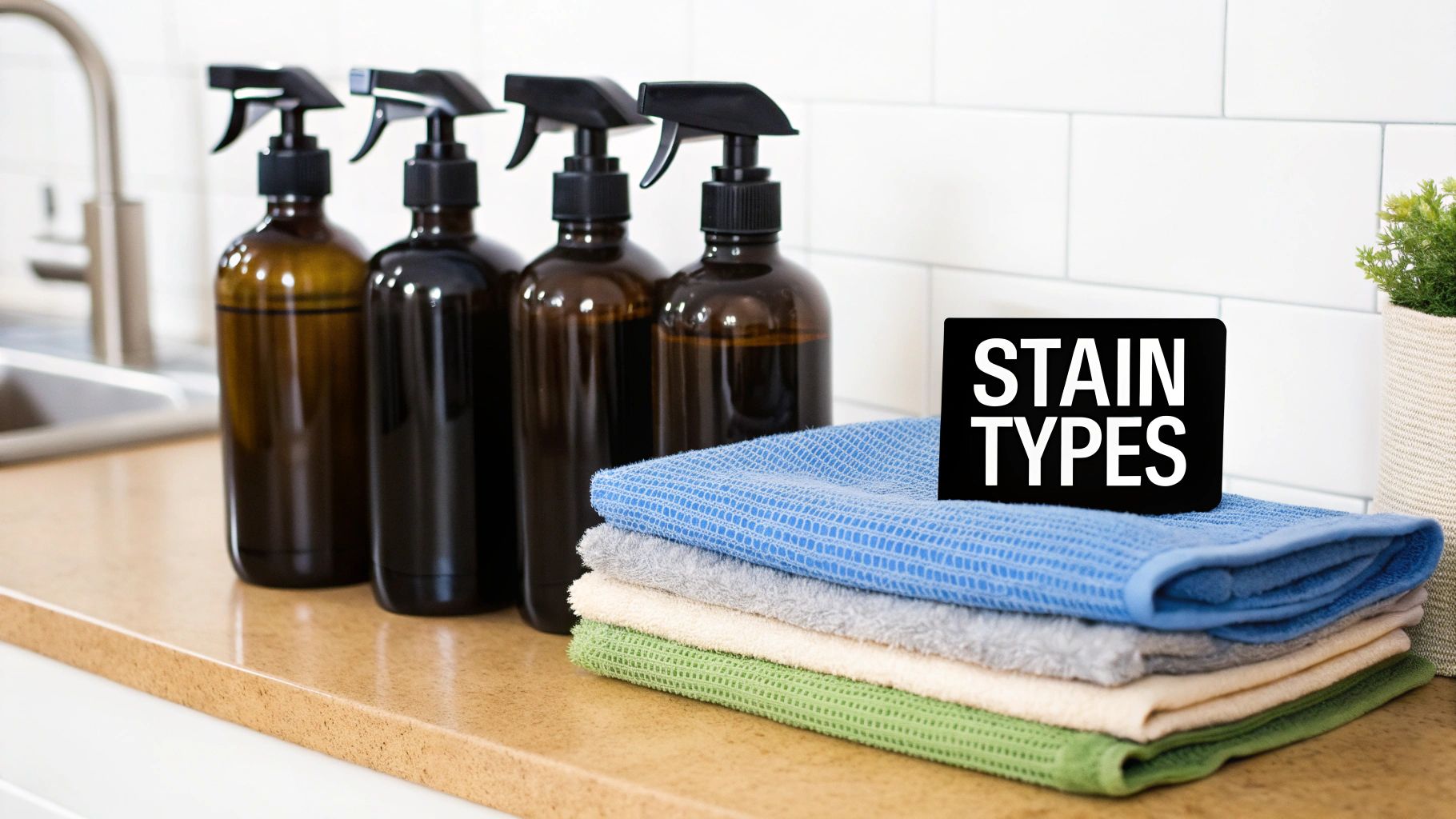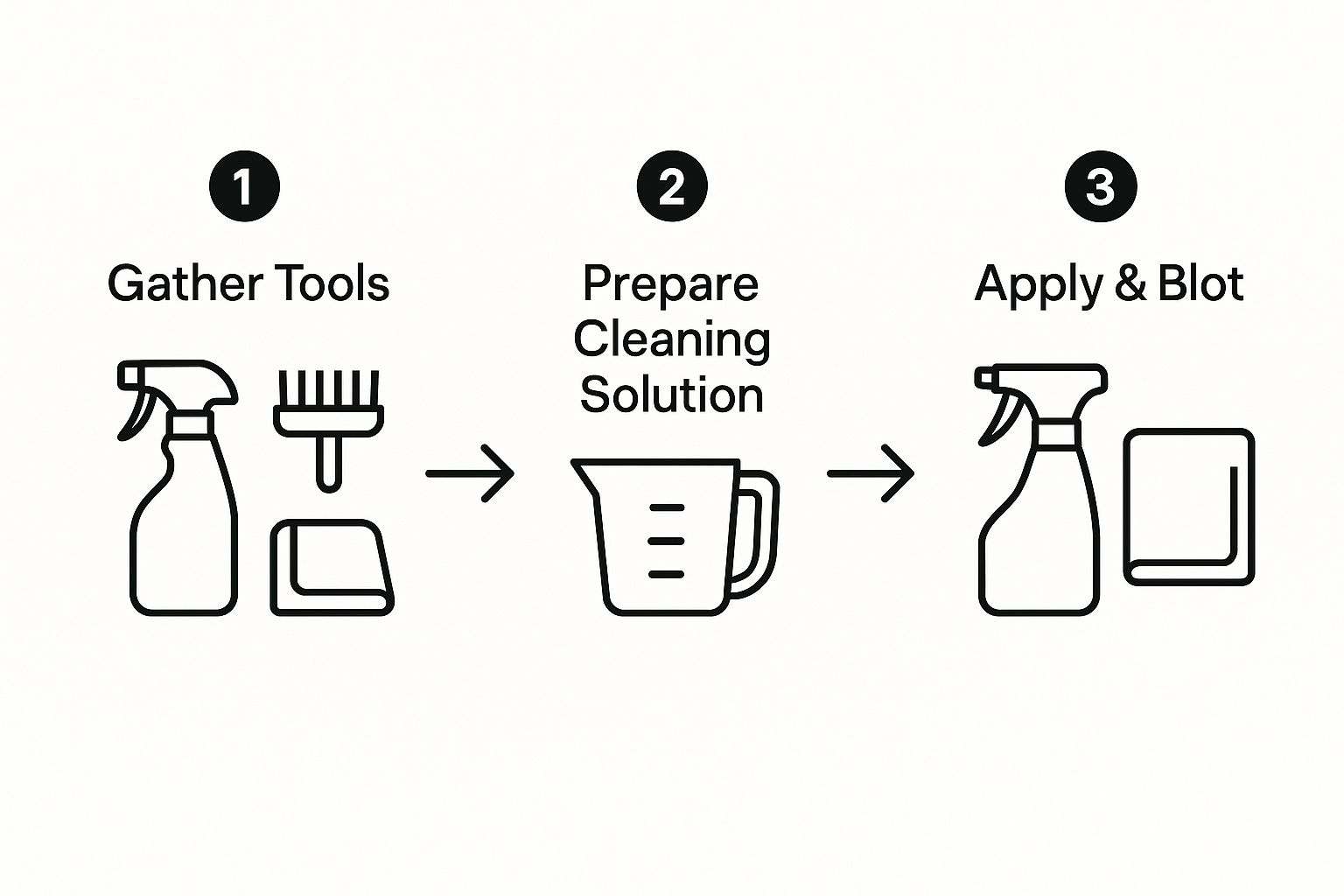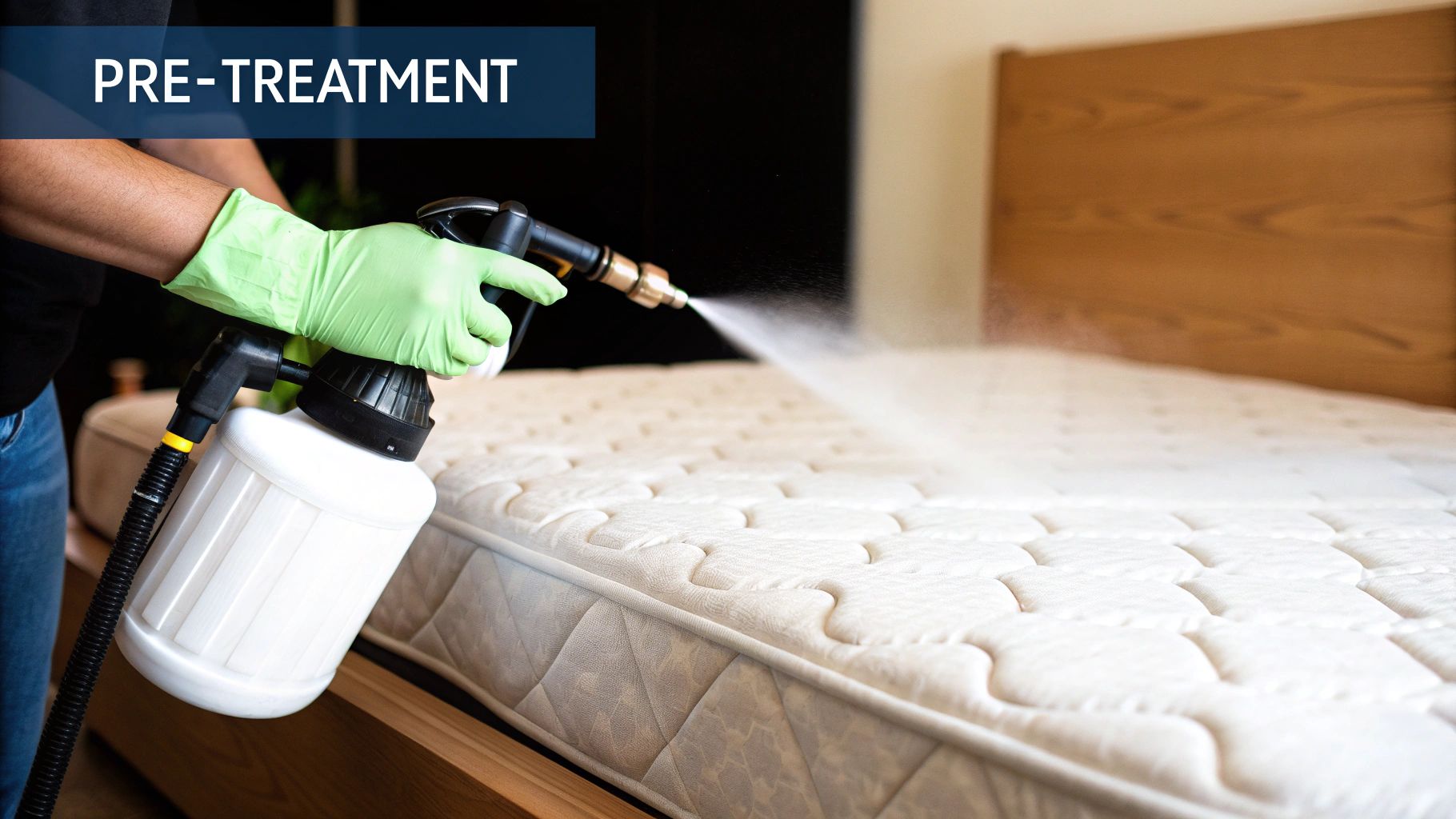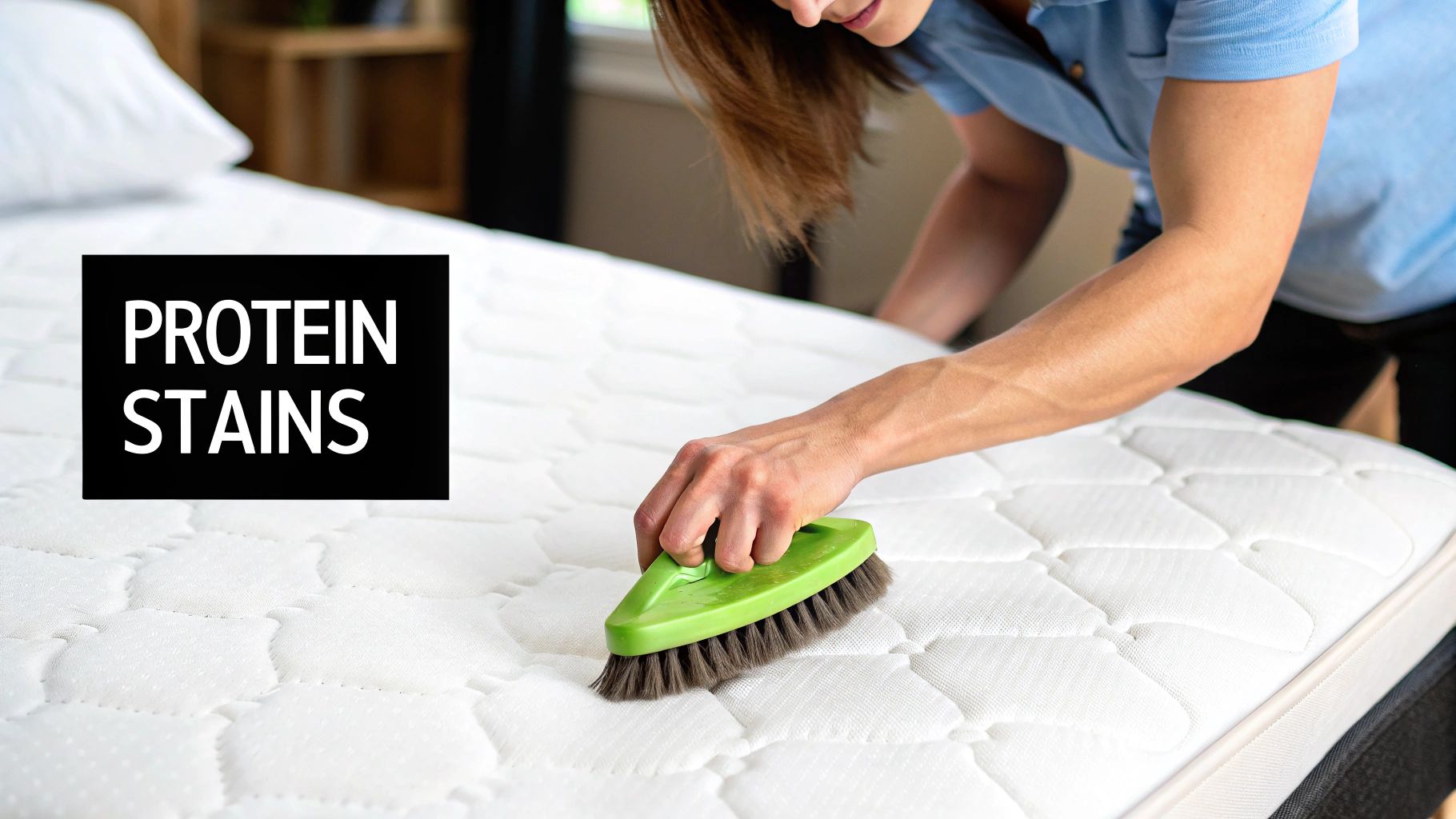That heart-sinking moment when you spill coffee on your pristine white sheets? We’ve all been there. It feels like a minor catastrophe, but the secret to winning the battle against bed stains is speed. For anyone wondering how to clean bed stains effectively, your first move should be grabbing a clean, dry cloth and blotting the area immediately. Don't rub! Blotting pulls the liquid out, while rubbing just pushes it deeper. Once you've soaked up the excess, a simple paste of bicarbonate of soda and water can work wonders.
Don't Let Stains Settle In
When a spill happens, think of it as a ticking clock. A fresh mark isn't just an eyesore; the liquid is already starting to worm its way into the fabric fibres, bonding with them and creating a perfect home for bacteria. Knowing how to tackle these spots quickly is your best defence against stubborn marks and funky smells. Letting a stain dry is the worst thing you can do. Once it sets, the pigments and proteins have had time to latch onto the material, making your job ten times harder.
More Than Just a Mark
Stains aren't just a cosmetic problem; they can genuinely impact the health of your sleep space. That damp spot can quickly become a breeding ground for bacteria and dust mites, which are notorious for triggering allergies. In fact, an average used mattress may have as many as 10 million dust mites inside. According to Choice Australia, stains from bodily fluids are a real hygiene concern and can develop unpleasant odours if not dealt with promptly.
Real-World Example: A child has a nighttime accident. If you leave it until the morning, the urine soaks deep into the mattress. Its acidic components start breaking down the fibres, and that unmistakable smell begins to set in. But if you act right away—blotting up as much liquid as possible and then applying a bicarb soda paste—you absorb the moisture and neutralise the acid, stopping the damage before it starts.
Your Stain-Fighting Toolkit From the Pantry

Before tackling those stains, let's pull together your cleaning kit. The most powerful weapons for learning how to clean bed stains are probably sitting in your kitchen pantry right now. Bicarbonate of soda (baking soda) is brilliant at absorbing moisture and odours, while white vinegar, a mild acid, acts as a fantastic natural disinfectant.
Choosing the Right Tool for the Job
You can't just throw anything at a stain and hope for the best. A protein-based stain like sweat needs a different tactic than a simple coffee spill. Here’s a quick rundown of go-to solutions:
- Bicarbonate of Soda (Baking Soda): Your best friend for fresh spills and stubborn smells. Mix it with a bit of water to make a paste.
- White Vinegar: An absolute champion for general cleaning and for tackling alkaline stains like urine. Keep a spray bottle with a 50/50 mix of vinegar and water handy.
- Mild Dish Soap: Perfect for cutting through anything greasy or oily. A few drops in cool water can work wonders.
Crucial Tip: Always do a patch test. Find a small, hidden spot on your mattress or sheets and apply your cleaning solution first. This simple step can save you from accidentally discolouring or damaging the fabric. For instance, knowing how to wash and care for down quilts properly means using a gentle approach.
If you're looking for more ways to keep things clean without harsh chemicals, exploring other non-toxic upholstery cleaning methods can give you even more great options.
A Step-by-Step Guide to Common Bed Stains
Right then, let’s get down to the nitty-gritty of stain removal. Knowing how to clean bed stains isn't about having one magic spray; it's about understanding what you're up against. Different messes require different tactics because their chemical makeup varies.

Think of it as your basic three-step mantra: get your gear, mix your solution, and then gently blot. Never, ever rub. Following this simple process helps you lift the stain without accidentally pushing it deeper into the fabric.
Stain Removal Cheat Sheet
For a quick reference, here’s a handy table to help you deal with the most frequent offenders on your bedding.
| Stain Type | Best First Step | Primary Cleaning Solution |
|---|---|---|
| Yellow Sweat/Oil | Blot with a dry cloth; don't add water yet | Spray with a 50/50 white vinegar and water mix |
| Blood | Blot immediately with cold water | Make a paste from bicarbonate of soda and cold water |
| Urine/Pet Accident | Blot up as much liquid as possible | Spray with a 50/50 white vinegar mix, then use bicarb soda |
| Coffee/Tea | Blot with a dry cloth | Apply a small amount of diluted liquid dish soap |
| Makeup | Scrape off solids, blot liquids | Dab with a cloth dampened with rubbing alcohol (test first) |
Getting Rid of Yellow Sweat Stains
We all perspire, and over time, this can leave stubborn yellow marks. These stains are mostly protein-based, but they also contain oils and salts that dig in once they've set.
- Pour a 50/50 mix of white vinegar and water into a spray bottle and lightly mist the stained area. You want it damp, not soaking wet.
- Let it sit for about 5–10 minutes so the vinegar's mild acidity can break down the stain.
- Grab a clean, dry cloth and blot the area firmly.
- Sprinkle a thin layer of bicarbonate of soda over the still-damp spot to absorb leftover moisture and odours. Let it dry completely, then vacuum it up. For more general fabric cleaning tips, you might find this guide on how to clean upholstery at home really helpful.
Tackling Stubborn Blood Stains
If you remember one thing about blood stains, make it this: always use cold water. Hot water will "cook" the proteins in the blood, bonding them permanently to the fabric fibres.
For a fresh stain, get to it immediately. Blot it with a cloth soaked in cold water. If you’re dealing with a more stubborn or dried stain, a bicarb soda paste is your best bet. Mix bicarbonate of soda with a little cold water until it forms a thick paste. Apply it directly to the stain and leave it for at least 30 minutes. Then, gently dab it away with a clean, cold, damp cloth.
Dealing with Urine or Pet Accidents
Accidents are a part of life. With these stains, you're fighting two battles: the mark itself and the lingering odour from uric acid crystals.
- First, grab a towel and blot, blot, blot. Absorb as much liquid as you possibly can.
- Reach for that trusty 50/50 vinegar and water spray. Give the area a liberal spritz, let it soak in for a few minutes, and then blot it again with a fresh towel.
- Cover the entire damp area with a generous amount of bicarbonate of soda. As it dries, it pulls the urine and the vinegar solution out of the fabric, taking the smell with it.
- Leave it for several hours, or even overnight. Once it's bone dry, just vacuum it all up.
Don't Skip This Crucial Final Step After Cleaning

It’s a great feeling when you’ve successfully lifted a stubborn stain, but hold off on making the bed. The single most important thing now is to make sure the area is bone dry. Even a tiny bit of lingering moisture is a welcome mat for mould and mildew.
First, grab a clean, dry towel and press it firmly into the damp spot. Put some real weight into it to soak up as much liquid as possible. With the excess blotted up, it's time to let the air do the work. Throw open the windows, point a fan directly at the spot, or run a dehumidifier.
Deodorise and Protect
Once the mattress is almost completely dry, generously sprinkle bicarbonate of soda over the entire cleaned area. It absorbs that last bit of dampness and neutralises any stubborn odours. Let it sit for a good few hours before vacuuming it all up.
To save yourself this headache in the future, a quality mattress protector is a game-changer. It acts as a waterproof shield, preventing spills from ever reaching the mattress itself. After getting your mattress back to pristine, you might be motivated to give your whole living space a refresh. For more ideas, check out this guide on how to detox your home.
When DIY Stain Removal Just Won’t Cut It

While pantry remedies are fantastic for most mishaps, some situations call for more than bicarb soda and elbow grease. Knowing how to clean bed stains is one thing, but knowing when to call for backup is just as important. If you're staring down a very old, deeply set-in stain or a massive spill, a DIY attempt might not be enough.
Making the Call to a Professional
Deciding to hire a professional cleaner isn't admitting defeat; it’s a smart move to protect your investment. Professional steam cleaning uses high-pressure hot water to get deep into the mattress fibres, killing off bacteria, dust mites, and allergens that home methods can't touch.
In Australia, professional mattress cleaning typically costs between $80 and $150, depending on the size and cleaning method. For a truly deep, sanitising clean, steam cleaning is usually the most effective option. You can find a breakdown of these costs to get a better idea of what to expect. Calling an expert can be the difference between saving your mattress and having to replace it.
Your Questions on Mattress Cleaning Answered
Even after you've got the hang of how to clean bed stains, a few lingering questions are normal. Let’s tackle some of the most common ones.
Can I Use a Hairdryer to Dry My Mattress Faster?
It's tempting to reach for the hairdryer, but please, resist the urge to use heat. High temperatures can essentially bake protein-based stains (like blood or sweat) into the fabric fibres, setting them for good. Instead, your best friend is cool air. Point a fan at the damp spot or use the cool shot button on your hairdryer. Patience will prevent you from accidentally making a stain permanent.
How Often Should I Deep Clean My Entire Mattress?
Even if your mattress looks spotless, a proper deep clean every six months is a must. It’s the only way to tackle the unavoidable build-up of dust mites, dead skin cells, and allergens. A quick vacuum each month also goes a long way in managing these tiny pests and creating a healthier place to sleep. If you have other product care questions, our Sienna Living FAQs are a great resource.
Sleep Soundly on a Fresh, Clean Bed
Now that you know how to defeat even the most common bed stains, you can rest easy. Keeping your sleep space clean is one of the best things you can do for your health and comfort. A clean bed is the cornerstone of a truly restorative night's sleep. To keep your mattress protected and take your comfort to the next level, have a look at the beautiful, hypoallergenic bedding from Sienna Living. Discover our premium bamboo sheets and mattress protectors today.

